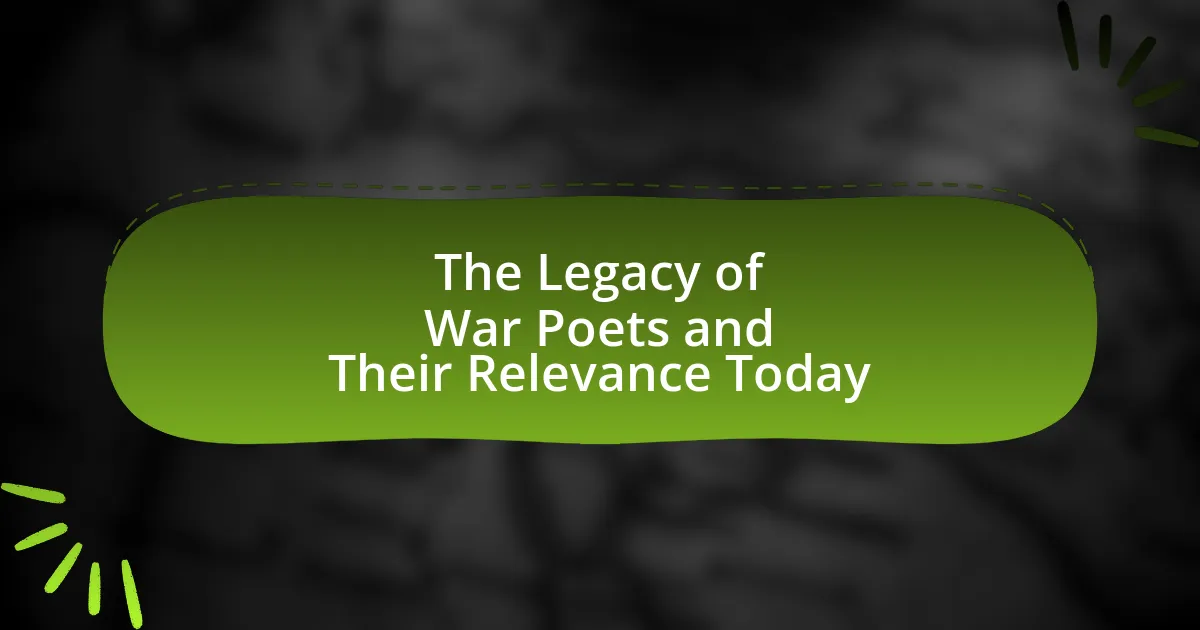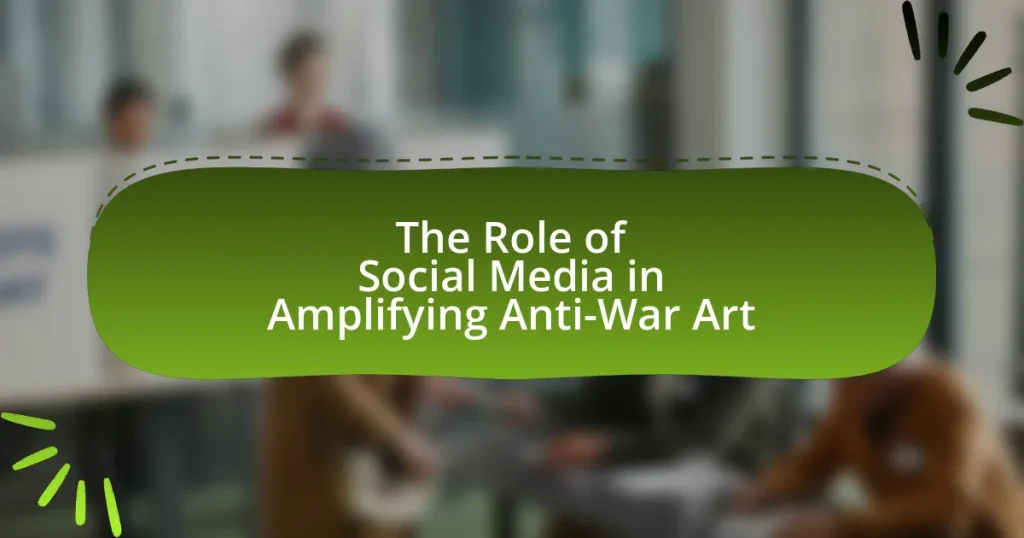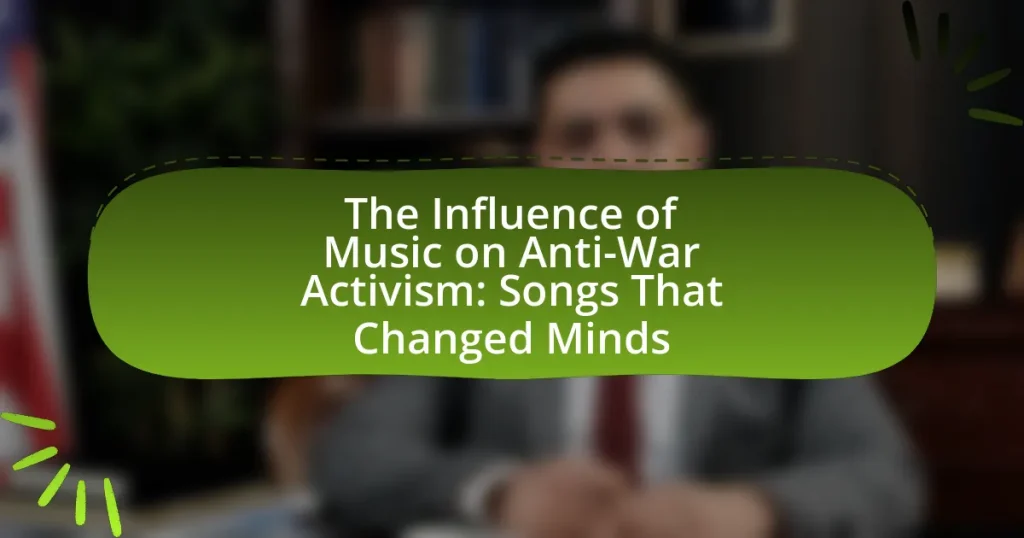The article examines the legacy of war poets, particularly focusing on figures like Wilfred Owen and Siegfried Sassoon, who articulated the emotional and psychological impacts of war through their poetry during World War I. It discusses how these poets emerged in response to the traumatic experiences of soldiers, challenging romanticized views of warfare and emphasizing themes such as suffering, disillusionment, and the futility of conflict. The article also highlights the ongoing relevance of their works in contemporary society, their influence on modern literature, and the lessons that can be drawn from their experiences, including the importance of empathy and understanding the human cost of war. Additionally, it explores how war poets are commemorated today and the ways individuals can engage with their legacy.
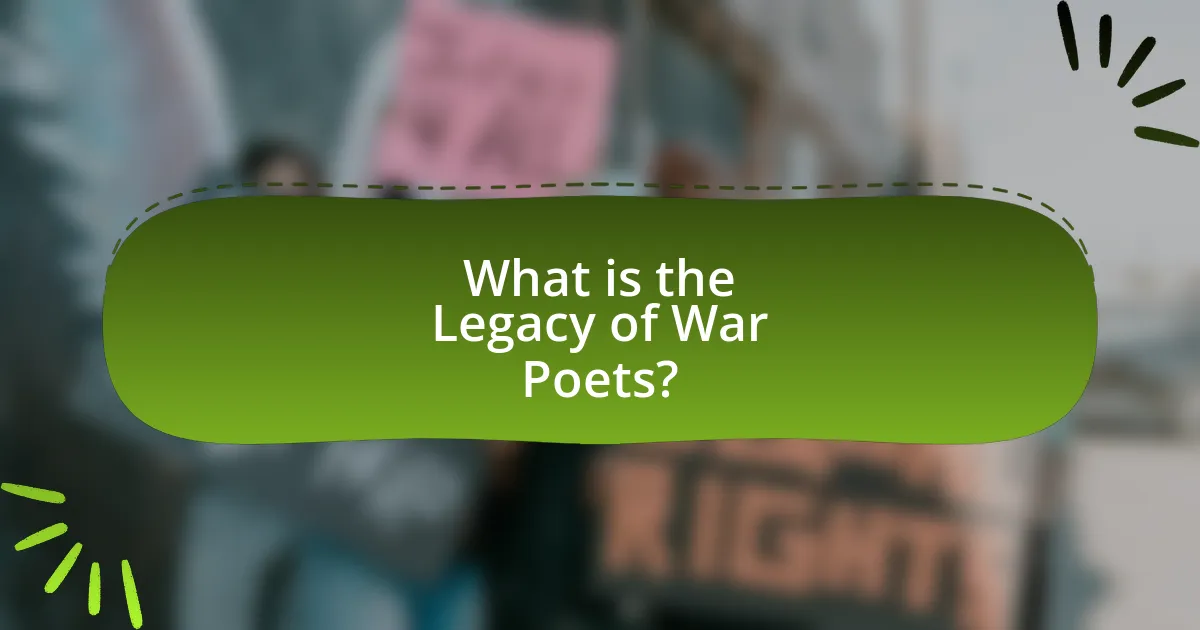
What is the Legacy of War Poets?
The legacy of war poets lies in their profound ability to articulate the emotional and psychological impacts of war, shaping public perception and understanding of conflict. War poets, such as Wilfred Owen and Siegfried Sassoon, used their experiences in World War I to convey the horrors of battle, emphasizing themes of suffering, disillusionment, and the futility of war. Their works, characterized by vivid imagery and poignant language, have influenced literature and continue to resonate in contemporary discussions about the human cost of war. The enduring relevance of their poetry is evident in its frequent inclusion in educational curricula and its impact on anti-war movements, highlighting the importance of personal narratives in understanding historical events.
How did war poets emerge during historical conflicts?
War poets emerged during historical conflicts primarily as a response to the traumatic experiences of soldiers and the realities of warfare. The First World War, for instance, saw poets like Wilfred Owen and Siegfried Sassoon articulate the horrors of trench warfare, using their personal experiences to challenge romanticized notions of war. Their works, often published in literary magazines and anthologies, reflected the disillusionment felt by many soldiers and civilians, providing a stark contrast to the propaganda of the time. This emergence was significant as it marked a shift in literary expression, where poetry became a medium for social commentary and emotional truth, influencing public perception of war and its consequences.
What were the key influences on the works of war poets?
The key influences on the works of war poets include personal experiences of combat, societal attitudes towards war, and the broader cultural context of the time. Personal experiences, such as those faced by poets like Wilfred Owen and Siegfried Sassoon during World War I, shaped their vivid depictions of the horrors of battle and the psychological impact of warfare. Societal attitudes, including the romanticized view of war prevalent before the conflicts, contrasted sharply with the grim realities depicted in their poetry, leading to a critical examination of nationalism and heroism. Additionally, the cultural context, including the influence of modernist literary movements and the disillusionment following the war, further informed their thematic choices and stylistic approaches, as seen in the works of poets like Rupert Brooke and Isaac Rosenberg.
How did the experiences of war shape their poetry?
The experiences of war profoundly shaped the poetry of war poets by influencing their themes, imagery, and emotional depth. War poets, such as Wilfred Owen and Siegfried Sassoon, drew from their firsthand experiences in combat, which led to vivid depictions of the horrors of war, the trauma of soldiers, and the disillusionment with romantic notions of battle. For instance, Owen’s poem “Dulce et Decorum Est” starkly contrasts the glorification of war with the grim realities faced by soldiers, using graphic imagery to convey the brutality of trench warfare. This direct engagement with the traumatic experiences of war allowed these poets to articulate the psychological and physical toll of conflict, making their work resonate with authenticity and urgency.
What themes are prevalent in the poetry of war poets?
The prevalent themes in the poetry of war poets include the horrors of battle, the futility of war, loss and grief, and the psychological impact of conflict. War poets, such as Wilfred Owen and Siegfried Sassoon, vividly depict the brutal realities of warfare, emphasizing the physical and emotional scars left on soldiers. For instance, Owen’s poem “Dulce et Decorum Est” illustrates the gruesome conditions faced by soldiers, challenging the glorification of war. Additionally, themes of camaraderie and the disillusionment with nationalistic ideals are often explored, reflecting the complex emotions experienced by those who served. These themes resonate with readers, highlighting the enduring consequences of war on individuals and society.
How do war poets address the concept of heroism?
War poets often critique the traditional notion of heroism by portraying the grim realities of war, emphasizing the suffering and trauma experienced by soldiers rather than glorifying their actions. For instance, Wilfred Owen’s poem “Dulce et Decorum Est” illustrates the horrific conditions of trench warfare, challenging the romanticized view of dying for one’s country as noble. This approach highlights the psychological and physical toll of combat, suggesting that true heroism lies in the endurance of soldiers amidst chaos rather than in acts of valor. By focusing on the human cost of war, poets like Owen and Siegfried Sassoon redefine heroism as a complex and often painful experience, urging readers to reconsider the glorification of war.
What role does trauma play in their poetry?
Trauma serves as a central theme in the poetry of war poets, reflecting their personal and collective experiences of conflict. This emotional and psychological impact manifests in vivid imagery, raw emotion, and a deep exploration of suffering, often highlighting the disillusionment and horror of war. For instance, Wilfred Owen’s works, such as “Dulce et Decorum Est,” illustrate the brutal realities of combat and the lasting scars it leaves on soldiers, effectively conveying the trauma experienced during World War I. Such depictions not only serve to document the effects of war but also aim to challenge romanticized notions of heroism, making trauma a critical lens through which these poets articulate their experiences and critique societal perceptions of warfare.
Why is the legacy of war poets significant today?
The legacy of war poets is significant today because their works provide profound insights into the human experience of conflict, suffering, and the psychological impact of war. These poets, such as Wilfred Owen and Siegfried Sassoon, articulated the brutal realities of warfare, challenging romanticized notions of battle and highlighting the emotional and physical toll on soldiers. Their poetry remains relevant as it fosters empathy and understanding of the consequences of war, serving as a reminder of the sacrifices made and the need for peace. The continued study and appreciation of their writings in educational settings and literary discussions underscore their enduring influence on contemporary views of war and humanity.
How have their works influenced modern literature?
The works of war poets have significantly influenced modern literature by introducing themes of trauma, disillusionment, and the stark realities of conflict. Their candid depictions of war experiences, such as those found in Wilfred Owen’s “Dulce et Decorum Est,” challenge romanticized notions of warfare and have shaped contemporary narratives around the psychological impacts of combat. This shift in perspective has led to a greater emphasis on authenticity and emotional depth in modern literary works, as seen in the writings of authors like Tim O’Brien and Michael Herr, who explore similar themes of war’s brutality and its lasting effects on individuals and society.
What lessons can contemporary society learn from war poets?
Contemporary society can learn the importance of empathy and the human cost of conflict from war poets. War poets, such as Wilfred Owen and Siegfried Sassoon, vividly depicted the brutal realities of war, emphasizing the emotional and psychological toll on soldiers. Their works serve as a reminder that war is not just a series of events but a profound human experience filled with suffering and loss. For instance, Owen’s poem “Dulce et Decorum Est” starkly illustrates the horrors of gas warfare, challenging the glorification of combat and urging readers to confront the grim truths of military service. This perspective fosters a deeper understanding of the consequences of war, encouraging contemporary society to advocate for peace and support veterans’ mental health.
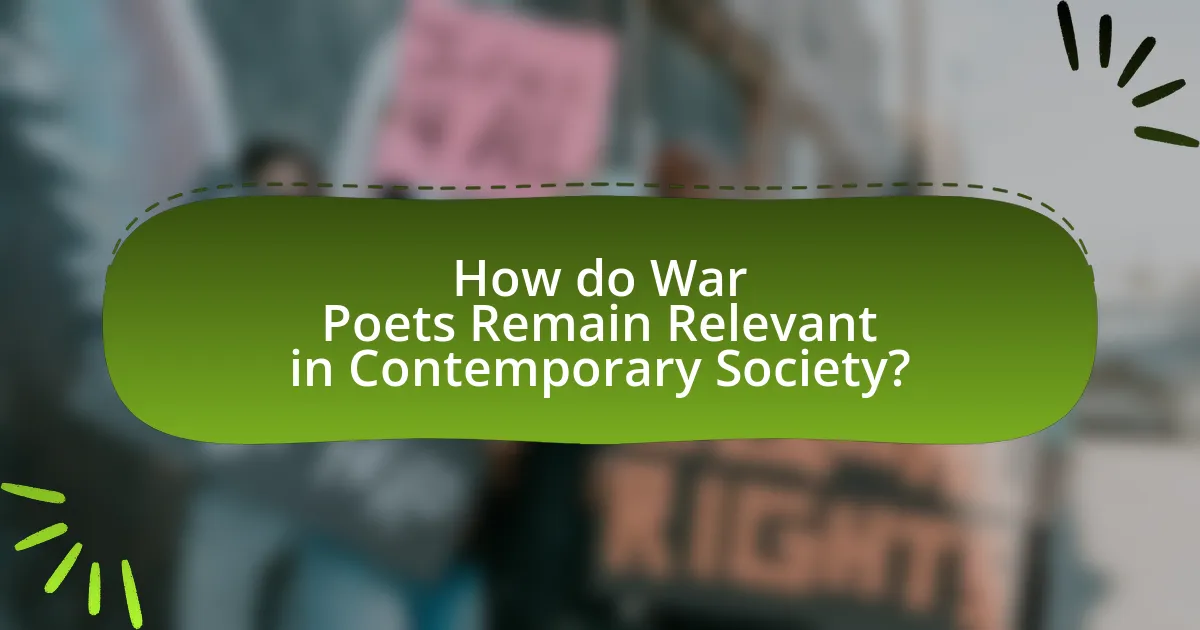
How do War Poets Remain Relevant in Contemporary Society?
War poets remain relevant in contemporary society by providing profound insights into the human experience of conflict, which resonate with modern audiences. Their works, such as those by Wilfred Owen and Siegfried Sassoon, explore themes of trauma, loss, and the futility of war, reflecting the psychological impacts that continue to affect soldiers and civilians today. For instance, studies show that literature addressing war can foster empathy and understanding, making the emotional truths conveyed by these poets significant in discussions about modern warfare and its consequences. Additionally, their poetry is often included in educational curricula, ensuring that new generations engage with these critical perspectives on war, thereby maintaining their relevance in cultural and social dialogues.
What parallels can be drawn between historical and modern conflicts?
Parallels between historical and modern conflicts include the use of propaganda, the impact on civilian populations, and the psychological effects on soldiers. For instance, both World War I and contemporary conflicts like the Iraq War utilized propaganda to shape public perception and justify military actions. Additionally, civilian casualties remain a tragic constant; during the Vietnam War, for example, millions of civilians were affected, similar to the civilian toll seen in modern conflicts such as Syria. Furthermore, the psychological trauma experienced by soldiers, evidenced by the prevalence of shell shock in World War I and PTSD in current veterans, highlights a consistent theme in the human experience of war. These parallels illustrate that despite changes in technology and tactics, the fundamental nature of conflict and its consequences on society and individuals remain strikingly similar.
How do war poets’ themes resonate with current global issues?
War poets’ themes resonate with current global issues by highlighting the psychological trauma, moral ambiguity, and the human cost of conflict, which remain relevant in today’s geopolitical landscape. For instance, the exploration of PTSD in war poetry parallels the mental health crises faced by veterans and civilians in modern conflicts, as seen in the ongoing wars in Syria and Afghanistan. Additionally, the critique of nationalism and the futility of war expressed by poets like Wilfred Owen and Siegfried Sassoon reflects contemporary debates on militarism and the consequences of war, evidenced by the rise of anti-war movements globally. These themes serve as a reminder of the enduring impact of war on society, emphasizing the need for empathy and understanding in addressing current global challenges.
In what ways do their messages transcend time and culture?
The messages of war poets transcend time and culture through their universal themes of loss, suffering, and the human condition. These poets, such as Wilfred Owen and Siegfried Sassoon, articulate emotions and experiences that resonate across different eras and societies, highlighting the shared pain of conflict. For instance, Owen’s poem “Dulce et Decorum Est” vividly depicts the horrors of war, evoking empathy and reflection that remain relevant regardless of the historical context. This emotional depth allows their work to connect with diverse audiences, fostering a collective understanding of the impacts of war. Additionally, the exploration of moral ambiguity and the questioning of nationalism in their writings challenge societal norms, encouraging critical thought that transcends cultural boundaries.
How are war poets commemorated in today’s world?
War poets are commemorated in today’s world through various means, including memorials, literary festivals, and educational programs. Memorials dedicated to war poets, such as the Wilfred Owen Memorial in Oswestry, serve as physical reminders of their contributions and sacrifices. Literary festivals, like the annual Wilfred Owen Festival, celebrate their works and promote discussions about the impact of war on society. Additionally, educational programs in schools incorporate war poetry into curricula, ensuring that new generations understand the historical context and emotional depth of these poets’ experiences. These methods collectively honor the legacy of war poets and keep their messages relevant in contemporary discourse.
What events or initiatives celebrate their contributions?
Events and initiatives that celebrate the contributions of war poets include poetry readings, literary festivals, and commemorative events held on significant anniversaries of wartime events. For instance, the annual Wilfred Owen Festival in Oswestry, England, honors the works of the renowned war poet through readings, performances, and discussions, emphasizing his impact on literature and society. Additionally, the Poetry Society in the UK often organizes events that focus on war poetry, showcasing the works of poets like Siegfried Sassoon and Rupert Brooke, thereby fostering appreciation for their contributions to the literary canon and historical discourse.
How do educational institutions incorporate their works into curricula?
Educational institutions incorporate the works of war poets into curricula by integrating their poetry into literature and history courses, emphasizing themes of conflict, human experience, and societal impact. This integration often includes analysis of specific poems, discussions on the historical context of the wars they represent, and exploration of the poets’ biographical backgrounds. For instance, the works of Wilfred Owen and Siegfried Sassoon are frequently studied to illustrate the emotional and psychological effects of World War I, thereby enhancing students’ understanding of both literary techniques and historical events. Such incorporation not only enriches literary studies but also fosters critical thinking about the implications of war and peace in contemporary society.
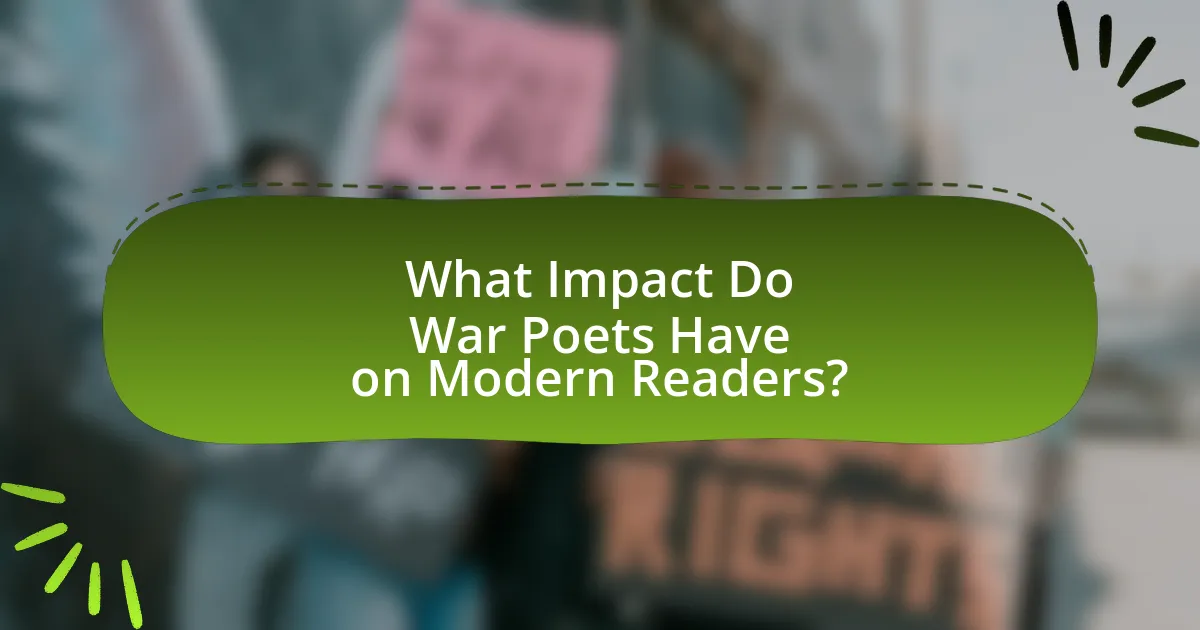
What Impact Do War Poets Have on Modern Readers?
War poets significantly influence modern readers by providing profound insights into the human experience of conflict. Their works evoke empathy and understanding of the psychological and emotional toll of war, as seen in the poetry of Wilfred Owen and Siegfried Sassoon, who vividly depict the horrors of World War I. This emotional resonance encourages contemporary readers to reflect on the consequences of war, fostering a deeper awareness of its impact on society. Additionally, the themes of loss, trauma, and the questioning of nationalism found in their poetry remain relevant, prompting discussions about the nature of conflict and its moral implications today.
How do readers connect emotionally with the works of war poets?
Readers connect emotionally with the works of war poets through vivid imagery and personal experiences that evoke feelings of loss, trauma, and heroism. War poets, such as Wilfred Owen and Siegfried Sassoon, utilize powerful language and sensory details to portray the brutal realities of combat, allowing readers to empathize with the soldiers’ experiences. For instance, Owen’s poem “Dulce et Decorum Est” graphically describes the horrors of gas warfare, creating a visceral reaction that resonates with readers. This emotional connection is further strengthened by the universal themes of suffering and sacrifice, which transcend time and place, making the poets’ messages relevant to contemporary audiences.
What psychological effects do their poems have on audiences?
War poets evoke profound psychological effects on audiences, primarily through the exploration of trauma, loss, and the human condition. Their poems often elicit empathy and reflection, allowing readers to connect emotionally with the experiences of soldiers and the impact of war. For instance, Wilfred Owen’s “Dulce et Decorum Est” vividly portrays the horrors of battle, leading to a visceral reaction that challenges romanticized notions of war. Research indicates that poetry can facilitate emotional processing and catharsis, as demonstrated in studies like “The Psychological Effects of Poetry on Readers” by Dr. James Pennebaker, which found that engaging with emotionally charged literature can enhance emotional well-being and promote healing. Thus, the psychological effects of war poetry are significant, fostering understanding and emotional resonance in audiences.
How can their poetry foster empathy and understanding?
War poets can foster empathy and understanding by vividly portraying the emotional and psychological experiences of soldiers and civilians affected by conflict. Their use of personal narratives and evocative imagery allows readers to connect deeply with the realities of war, transcending mere statistics or historical accounts. For instance, Wilfred Owen’s poem “Dulce et Decorum Est” illustrates the horrors of trench warfare, compelling readers to confront the brutal truth of combat rather than romanticizing it. This direct engagement with the human cost of war encourages readers to empathize with those who suffer, fostering a greater understanding of the complexities of conflict and its aftermath.
What are some notable contemporary works inspired by war poets?
Notable contemporary works inspired by war poets include “The Not Dead” by Simon Armitage, which reflects on the experiences of soldiers and the impact of war, and “The Yellow Birds” by Kevin Powers, a novel that draws on the emotional and psychological toll of combat. These works echo the themes of loss, trauma, and the human cost of war, similar to the writings of World War I poets like Wilfred Owen and Siegfried Sassoon. Additionally, “War Music” by Christopher Logue reinterprets Homer’s “Iliad” through the lens of modern warfare, illustrating the timeless nature of war’s brutality and its effects on humanity.
How do modern poets draw inspiration from the legacy of war poets?
Modern poets draw inspiration from the legacy of war poets by exploring themes of trauma, loss, and the human condition in the context of conflict. War poets, such as Wilfred Owen and Siegfried Sassoon, vividly depicted the horrors of war, influencing contemporary writers to address similar emotional and psychological impacts of violence. For instance, modern poets often utilize stark imagery and personal narratives to convey the complexities of war experiences, reflecting the ongoing relevance of these themes in today’s global conflicts. This connection is evident in works that echo the stylistic and thematic elements of war poetry, demonstrating how the legacy of past poets continues to resonate in contemporary literature.
What innovations in poetry have emerged from their influence?
Innovations in poetry that have emerged from the influence of war poets include the use of stark imagery, free verse, and a focus on personal experience and emotional truth. War poets like Wilfred Owen and Siegfried Sassoon introduced vivid depictions of the horrors of war, which shifted the poetic landscape from romanticized notions of battle to a more realistic and often brutal portrayal of conflict. Their emphasis on individual perspective and psychological depth has led to a broader acceptance of diverse voices and styles in contemporary poetry, allowing for greater exploration of themes such as trauma, identity, and social critique. This evolution is evidenced by the rise of confessional poetry and the incorporation of multimedia elements, reflecting the ongoing impact of war poets on modern literary forms.
How can individuals engage with the legacy of war poets today?
Individuals can engage with the legacy of war poets today by studying their works, participating in discussions, and attending commemorative events. Engaging with the poetry allows individuals to understand the emotional and historical contexts of war, as seen in the writings of poets like Wilfred Owen and Siegfried Sassoon, who vividly depicted the horrors of World War I. Participating in book clubs or online forums dedicated to war poetry fosters dialogue about its themes and relevance, while attending events such as poetry readings or memorials honors the poets’ contributions and keeps their messages alive. These activities not only preserve the poets’ legacies but also encourage reflection on the impact of war in contemporary society.
